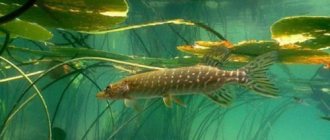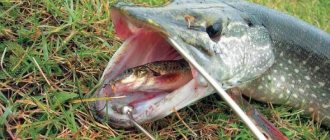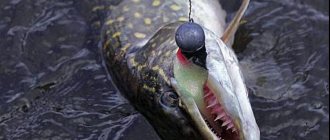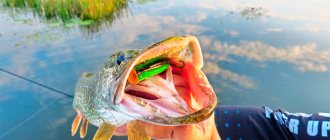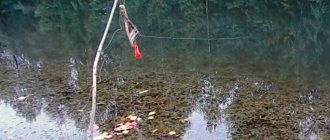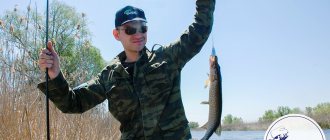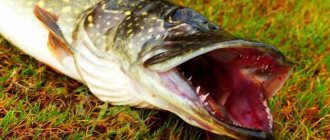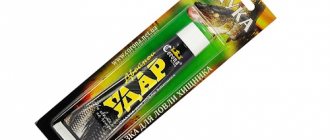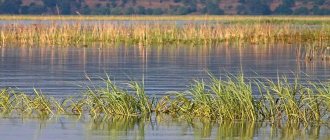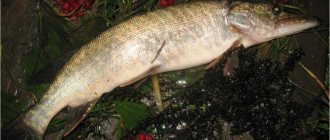Three main advantages. How to tie a fly (streamer) for pike fishing, what types of rigs there are, how to catch pike with a fly.
Recently, the popularity of pike flies has increased significantly. Fishermen in many regions of the country successfully catch with homemade flies made from scrap materials. You can also buy these baits in some fishing stores.
“Pike flies” – streamers
Previously, soft pike baits were called “pike flies”; some people still call them that. But now it has become fashionable to call them streamers (translated from English, “streamer” is a narrow long ribbon), and although this name does not accurately reflect the design of a pike fly, this word has stuck with us, and we will use it.
Streamers have three main advantages
Firstly, the predator on many reservoirs is still new to these soft baits, which fearlessly attack even the most wary individuals.
Secondly, a fly for pike, due to its design, allows retrieving at any speed, including the slowest - the bait is very lively, mobile in the water, and even when the softest, most active twister wilts, the streamer will play. Only a very slow retrieve can work on a very lethargic pike - in the summer heat, during sudden changes in weather, in early spring after spawning. The same is true with super-fast wiring - even if it is on a river stream of any strength and complexity, it is practically impossible to knock this trick out of the game. And with appropriate loading, you can move the bait both on top, and in the middle layers of water, and at the very bottom at any depth - the same “jig streamer” is increasingly proving its catchability not only for pike, but also for perch, pike perch and even catfish.
Thirdly, contrary to popular belief, I will say that it is not at all difficult to make a good streamer for pike yourself. In any case, it’s easier and an order of magnitude faster than a spinner, and especially a wobbler. The main thing is the desire to knit something! And then the question: how to tie a fly will not be so uncertain.
Spinning fishing with a streamer
As mentioned above, not all spinning baits can boast of sufficient catchability, since they do not always imitate the high-quality, and most importantly, natural play of a real fry. To solve the problem, anglers supply silicone products, spoons or wobblers with additional accessories . However, this can be avoided by using a unique artificial bait - a streamer.
The method of spinning fishing for streamers began to develop relatively recently, but recently many fans of spinning have become interested in it. Among the advantages of such fishing are the ease of making bait and the absence of wiring difficulties. But there is also a downside to the coin in the form of the inability to make accurate long-distance casts.
Of course, you can find a way out of the situation by equipping the fly with additional weight, however, after this it will lose its former lightness and stop playing as interestingly as before. Therefore, experts recommend adding a small amount of lead wire to the hook, or clamping a couple of small weights on it.
Site selection and tactics
If you are going to fish with a spinning rod , then choose the right places for casting. Among them:
- A lake overgrown with all kinds of vegetation, difficult to reach with a classic spoon.
- Areas with coastal thickets of reeds and reeds.
- Snag.
And many other hard-to-reach places.
Before visiting a pond, it is important to check the weather forecast , because the bite may depend on it. In lake conditions, those types of baits that are reliably protected from snags by special wire or fishing line work well.
The presence of an additional sinker will allow you to sink the bait to a sufficient depth, which is important for studying holes and relief changes. When casting bait into places with thickets of algae, it is necessary to use a jerk retrieve, with short pauses.
If fishing is carried out in shallow water areas, then it is advisable to use long jerks with periodic stops, which are selected taking into account the activity of the fish. Dark streamers work great in hot weather, and bright ones in cloudy or cold weather.
Materials for tying flies
All suitable materials can be bought in specialized stores, making your streamers from the best, although good materials (synthetics, fur, feathers) can be found anywhere - in the closet at home, in cutting and sewing stores, in markets selling all sorts of Chinese small things. I don’t advise you to immediately buy a lot of the material you like, like fur. It is always more profitable to take only a small piece and see how it behaves in the water when stretching, stopping... If when stretching everything “sticks together and wrinkles,” then such fur is not suitable. The slightest vibration from the water flow must be transmitted to the material, only then will it turn out to be a good bait.
For a pike streamer, the main material on which “you won’t get any bumps” is rabbit fur . If not just fur is used, but with a piece of leather, then it should be soft. Otherwise, it will stand like a stake and not work properly. The tail fur of a silver fox or an ordinary fox is also good. For knitting streamers, embroidery floss threads, threads with lurex, Christmas tree rain are suitable, you can tie different feathers to a hook - why not!? You can try any suitable natural and synthetic material. Imagination in this matter is only welcome, the main thing is that it does not become too “violent”, because the basis of a good streamer (like any other spinning bait) is not so much the appearance as the game.
Lures for fly fishing for pike
Lures for pike fly fishing - pike streamers and spinners - tubes for catching large salmon fish. You can knit streamers and tubes yourself; the tying technology is exactly the same as when tying any fly fishing flies. Only hooks or doubles are used in good pike sizes.
Working streamers for fly fishing for pike.
Excellent streamers are now being knitted by St. Petersburg craftsmen who not only copy the products of foreign fly fishermen, but also develop their own modifications of streamers for the reservoirs of the North-West and the European part of Russia.
Attempt at writing
Someone buys a ready-made streamer to “replicate” for themselves. Or you can improvise by making a bait as your heart desires.
A special bobbin holder for a spool of thread is convenient for knitting (winding). It easily releases the mounting thread when winding, and when in weight it pulls back well, preventing the winding on the hook from loosening. But this thing is quite expensive and in short supply, and our own fingers will do for our work.
We will choose large hooks - from No. 4 and above. Instead of a special hook clamp, you can use a regular small vise - they are less convenient, but they will do the job. We clamp the hook in a vice (with the tip down) and tightly wrap the thread around the shank near the ring of the hook. We carry the winding further along the forend, not necessarily turn to turn - for now you just need to bring the thread to the thread.
You can make a streamer from two strips of rabbit fur. White fur will go on the tail, red fur on the body. Each strip is about 8 cm long, 2-3 mm wide, cut out with sharp scissors. We remove excess fur from the white strip. Then, using scissors, we remove about 2 cm of strips from the fur in order to make a winding in this place. We apply the freed part to the shank of the hook closer to the hook. We wrap the tail, making a winding of about 2 cm. We cut off the edge of the red strip a little at an angle, and wrap the corner. Then we return the thread to the ring of the hook by winding it so that it does not interfere with further work; we wrap the free red strip of fur around the shank of the hook, moving towards the ring. We adjust each turn with a finger so that they lie evenly. The result is a beautiful red pipe cleaner. I make a head with a tight winding around the ring of the hook and tie several knots. The streamer is almost ready. Let’s improve it a little by attaching a pair of “whiskers” made of wide Christmas tree rain 1-1.5 cm long to the head. We cover the head with varnish so that it does not come undone. You can go for pike and try to catch it.
If the streamer is intended for the river, then a wide variety of hard fur will do. Good from the tail of a calf (in an adult cow it is too curled), from the side of a goat, long hard dog fur, wolf fur. When using such materials, you just need to be sure to remove the soft undercoat - fluff.
If you are making a streamer for standing water, then on the contrary, soft fur is good, including synthetic fur; you can also successfully use feathers from a boa scarf, which are often sold in markets.
But let's finish knitting our streamer. We attach two small bird feathers to the sides of the bait. We grab them with a tight winding at the ring of the hook. We wind it well, forming a head, then cover it with varnish. That's it, the second streamer is ready.
Features of fishing with old bait
Wabiks and streamers are not the main bait. Rather, they perform an additional function: predators are attracted by the unusual appearance, and they rush to the bait. You can attach not one wobble to the tackle, but several. The main thing is to keep the distance between them within 25 cm. You can attach them directly to the forest or on leashes in front of the main bait.
If there are enough fish in the reservoir and you find a large school, then the wabiki are attached in the form of a “train”. This type of equipment allows you to get a rich catch with one cast. Moreover, such baits are suitable for catching any predators living in a reservoir.
If the reservoir is large, then you can use stepped jerk wiring. This method allows you to catch fish over a long distance.
Let's sum it up
As already mentioned, wabiki and streamers have been used in fishing for a long time. But they are used in different ways, since unified rules have never been invented. And each breed of fish behaves differently, and the reservoirs are also different. But this is attractive in itself. Fishermen can create their own baits and experiment with them, and use their imagination in composing their fishing equipment. They themselves select a variety of materials, color palette and figure out how best to use it all. The main thing, after all, is the maximum fishing result!
To be convinced of our words, watch the video, which shows options for using wabiks when fly fishing for pike, trout, asp, perch and other predators. So, wide horizons open up for fishing lovers.
Knitting Basics
There are many subtleties and special materials in the manufacture of various streamers that help create baits that are irresistible to fish. We are talking about “testing the pen”, but in this matter it is important to follow a few simple but important rules. In order for the first “pancake” not to come out lumpy, the streamer must be symmetrical - this is very important, otherwise it will collapse, go sideways, in other words, the work will be unpredictable. It is especially important to secure the feathers symmetrically, and they themselves must be absolutely identical. Any material on both sides of the bait should be distributed evenly.
In addition, each streamer has certain proportions that allow the bait to play well. So, for our first “rabbit” streamer, the tail needs to be shortened a little - so that it is no longer than the body of the bait, this is one of the rules for baits of this type; feathers - “wings” should only protrude slightly beyond the hook, and the fur tail should not be longer hook width.
About the best color
As for the best color, each angler has his own preferences. One takes only for white ones, the other only for light green ones. Who believes in what? In any case, in streamers, including pike, there is a huge palette of colors. Toothed combinations of white and red, pure white, yellow-red, red-black, yellow, green, pink, crimson colors work. Pike reacts remarkably to a purple tint, which also works on pike perch and pike perch. But when a pike eats, it doesn’t care what color the bait is. By the way, in the pike activity and “toothiness” lies the disadvantage of the streamer: it can withstand a dozen bites, or maybe just one. Here, as with tires, depending on your luck. When fishing for pike perch and pike perch, streamers “live” longer.
Fly fisherman's equipment
For pike fly fishing by wading, the fly fisherman’s equipment is standard:
- Waders.
- Wading boots.
- Thermal underwear.
- Short vest.
- Kukan for fish.
When fly fishing for pike from a boat, you can do without wading equipment. In any case, an angler who goes pike fishing with fly fishing should have with him either a good extractor or pliers with long handles. Sticking an unprotected hand into a predator’s mouth to extract a streamer is categorically undesirable.
More on this topic on our website:
- Catching pike with a float - collecting gear Fishing for pike with a float becomes relevant at the time of the spring spinning ban, when spinning anglers cannot go out on the water...
- Choosing the optimal spinning rod for pike - length, test, action To choose a spinning rod for pike that will meet all the features of a particular fishing, it is worth considering the characteristics of the spinning rod, such as length,…
- Tackle for pike fishing - the choice of a beginner For a beginner to go pike fishing, desire alone is not enough - he also needs gear for pike fishing, even if only...
- Pike fly fishing - where and when to catch To check how pike is caught by fly fishing, you don’t have to wait for the end of the spawning ban. For this fishing, a small body of water, remote from…
Streamer installation
The time has come to mount an almost weightless streamer on spinning equipment, which allows you to cast far and make the wiring in the required horizon. An effective streamer is assembled on two soft metal leads about 30 cm long, working in tandem with a large five-centimeter vibrator. Each leash has a fastener on one side and a swivel on the other - these are the ones that are mostly sold. The spinner is attached to one leash through a clasp, and the second leash is attached to the opposite end (where the swivel is) with a clasp. We fasten the streamer to the same fastener - by the ring of the hook.
This two-lead rig is simple, reliable, and maintains the integrity of the gear during powerful pike attacks on the bait. You can also quickly remove the streamer or exchange it for another one at any time. The equipment has proven itself well on the river and lake. The wiring is standard for oscillators. Most often, I fish evenly - the yaw movements of the spoon and the streamer's play will be attractive. Based on statistics, the spinner and the streamer give approximately the same number of pike bites. That is, if one spinner fishes with a “naked” spoon, and the second fishes in tandem with a streamer, then the second will have an order of magnitude more bites.
Of course, an additional hook often brings an additional hook. You understand this especially well when the fish is sitting on a streamer, and a spoon with a tee is dangling from behind, which is trying to find a branch or strong grass. Therefore, having raised the pike to the surface, I pay attention to what it took. When the streamer is not visible, it means that I grabbed it, and I fish it out carefully so that the vibrator does not get caught on anything. If the streamer dangles safely in front of the pike's muzzle, then I fish much more boldly - it sits on the tee of the spoon.
A streamer on a paternoster often helps out
To the same “eye” of the swivel we attach a leash with a streamer and a leash with a sinker. We knit the main fishing line to the second “eye”. Paternoster as such is often disliked by some anglers, both spinning anglers and bottom fishers, due to the large number of overlaps. To avoid them, there is a simple trick: the length of the leash with bait should be at least twice as long as the leash with a weight. The weight leash can be made very short (there should be no overlap) - when there is a desire to hold the bait closer to the bottom. Usually I make the length of the leash with bait 60-80 cm, the length of the leash - 30-40 cm.
Similar equipment can be made on a three-way swivel or on a wire rocker - this is not so important. Another important thing is that the paternoster, with a simple uniform reeling, allows you to carefully fish the steepest lake and river drop-offs. The traditional jig head here either gets stuck in the edge, or “jumps” over it too high, and the paternoster goes like a charm - the weight stretches along the bottom, the streamer plays a little higher.
I also use the paternoster on the riffles when catching small pike, perch, and chub. With the rig you can fish with drift, drive both against and with the current, carefully fishing almost every centimeter of the riffle. Walking along the sandy bottom, the load raises small clouds of turbidity, and a streamer plays along it from behind - a catchy tandem.
A jig with a streamer works on a similar paternoster
The only difference is that instead of a regular sinker we use an “eared” one with a hook and a twister. The wiring is both uniform and smooth step. And the bycatch of pike and pike perch on a streamer can be very significant, especially starting from the second half of summer. In the fall, even large bream sat on such equipment.
The streamer itself can become a jig bait, getting as close as possible to the sinker, connecting to it through a clasp. With such a bait, regular jig fishing is carried out: with heavy loads - in great depths and powerful currents, with light loads - in shallow riffles and lake coastal shoals, it’s good to throw along water lilies. You just have to remember that in still water the streamer does not have its own game if it is loaded closely with something. Therefore, uniform reeling may not work, but there are many options for retrieving - the game, first of all, lies in the hands of the fisherman, and this applies to all baits, not just the streamer.
How to master ultralight fishing
Tricks for catching crucian carp and tench in summer
Unsuccessful feeder catch
Fly fishing gear for pike
You can catch pike with fly fishing on a rod of any class, just as you can catch pike with a spinning rod and heavy rods and UL rods. However, as in spinning, there is the concept of comfortable fishing for fish. At the same time, the faster the fishing occurs, the less effort the fish spends. This means that you have every chance of releasing the pike into its native element after catching it. And the predator will have every chance to calmly move away after the fight with the fisherman and again begin to move and breathe in the water element.
Therefore, class 4-6 gear should be used when fly fishing for pike of the smallest size - up to 2 kg. It is better to catch any pike over 2-3 kg using more powerful fly fishing gear - class 8-9. And it’s even better to catch thick trophy pike on rods of class 10-11, which are two-handed and have powerful forms in the butt, designed to fight strong freshwater or sea predators.
A class 9 two-handed rod is quite suitable for fly fishing for large pike.
The reels are matched to the rod. Reels of 5-6 classes for rods of 4-5 classes, reels of 8-10 classes for rods of 10-11 classes.
When fishing for large pike, it is always advisable to have a decent supply of line on the spool - every spinning angler knows this. Likewise in fly fishing for pike - it is better to have a good supply of strong backing, for which they use reels of a class higher than the class of the rod.
A reel for fly fishing for pike should be selected for a specific rod and specific fishing conditions.
Cords, on the contrary, are better to choose 1-2 classes less than the class of the rod. That is, for a class 8 rod you can easily use a class 6 line. This will allow you to make more accurate casts when fly fishing for pike - after all, you have to look for pike among snags and bushes on a pond.
This type of cord for a two-handed fishing rod is suitable for fly fishing for pike.
If you are using a two-handed rod, it is also better to select cords for specific fishing conditions - based on the usual casting method used and depending on the location - open or cramped.
A prerequisite for successful fly fishing for pike is the use of a Kevlar or thick fluorocarbon leader. It is not advisable to use steel or tungsten leaders; they are stiffer and less suitable for fishing with streamers.
